Biocytogen은 GAN 식이/GAN+CCL4 유도 NASH 마우스 모델, 고지방 메티오닌 콜린 결핍(HFMCD) 유도 NASH 마우스 모델, STAM-NASH 마우스 모델 등 다양한 유도형 NASH 마우스 모델을 구축했습니다.
이 페이지에서
비알콜성 지방간 질환(NAFLD)은 과도한 지방이 간에 축적되는 것으로 특징지어지며, 과도한 음주와는 관계없이 여러 질환을 대표합니다. 지방간 외에도 NAFLD는 간염, 간세포 손상, 섬유화, 간 흉터 형성 등의 병리학적 변화를 동반하며, 궁극적으로 간경변이나 간암으로 진행될 수 있습니다. 비알콜성 지방간염(NASH)의 진행 메커니즘은 명확하지 않지만, 제2형 당뇨병과 NAFLD의 공존은 NASH로 발전할 위험을 증가시킵니다.
NASH의 임상 증상은 복잡하며, 비만, 인슐린 저항성, 지방성 간염, 간세포 팽창, 섬유화 등이 포함됩니다. NASH의 전임상 실험에 사용되는 동물은 유전자 변형된 것, 식이 유도된 것 또는 두 가지의 조합입니다.
인간의 질병 모든 병리학적 특징을 모사하는 것은 도전적이지만, NASH의 유도 및 진행 메커니즘을 이해하고 혁신적인 치료법을 개발하기 위해 우리는 NASH 발병 과정의 다른 단계를 대표하는 여러 마우스 모델을 구축했습니다.
각 모델은 ??타나는 표현형이 약간 다릅니다. 우리의 전문가들은 목표 특성에 맞는 적절한 모델을 선택하는 데 도움을 드립니다.
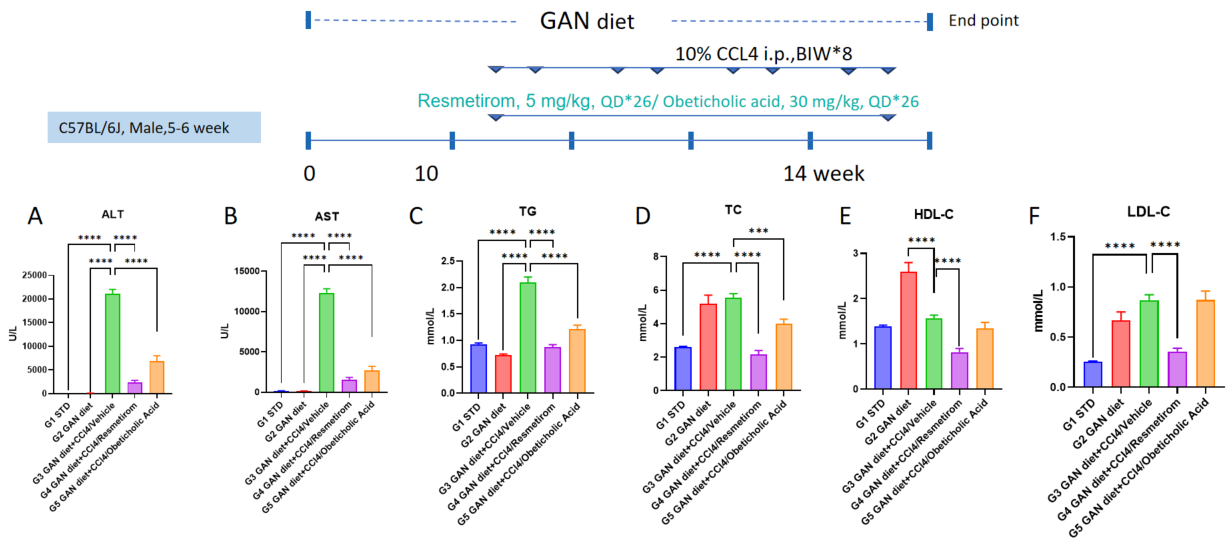
MGL3196과 OCA는 GAN 식이+CCL4로 유도된 NASH 마우스 모델의 증상을 완화시켰다. A-B, 모델링 및 치료군의 ALT 및 AST 수준. C-F, 모델링 및 치료군의 TG, TC, HDL-C, LDL-C 수준. 데이터는 평균 ± SEM으로 표시됩니다. 각 군 N = 9 마리의 마우스. *p<0.05, **p<0.01, ***p<0.001.
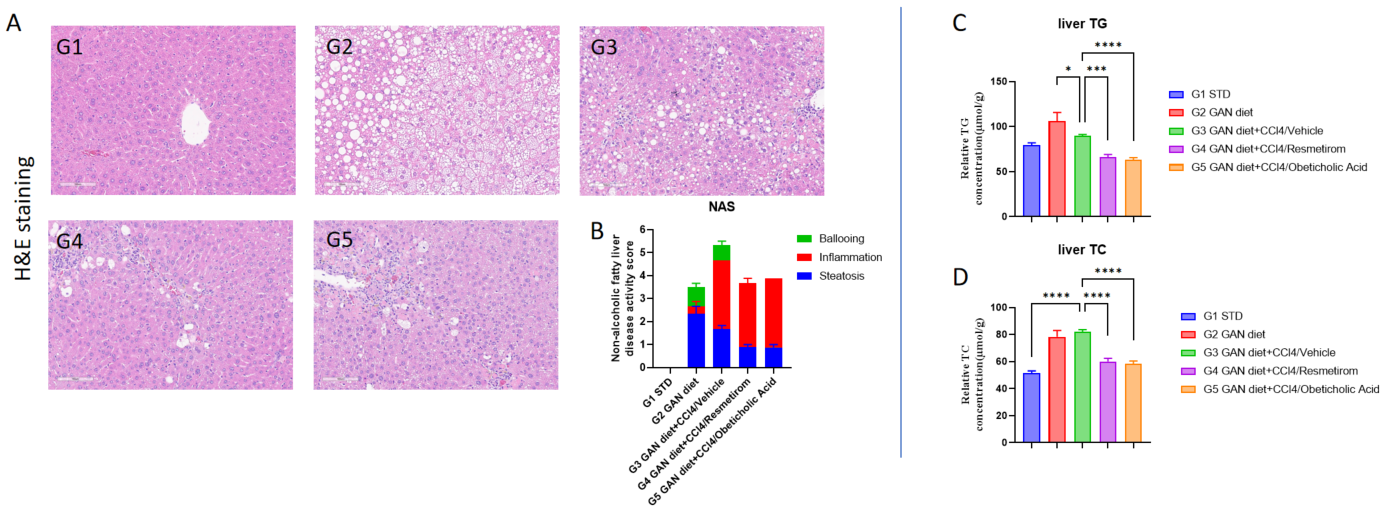
Resmetirom과 OCA는 NAS 점수를 감소시켰다. A, H&E 염색의 대표적인 이미지에서 NASH 정도를 나타냄. B, 외부 전문가 병리학자가 평가한 NAFLD 활동 점수(NAS). C-D, 치료 후 간의 TG 및 TC 함량. 데이터는 평균 ± SEM으로 표시됩니다. 각 군 N = 9-10 마리의 마우스. *p<0.05, **p<0.01, ***p<0.001.
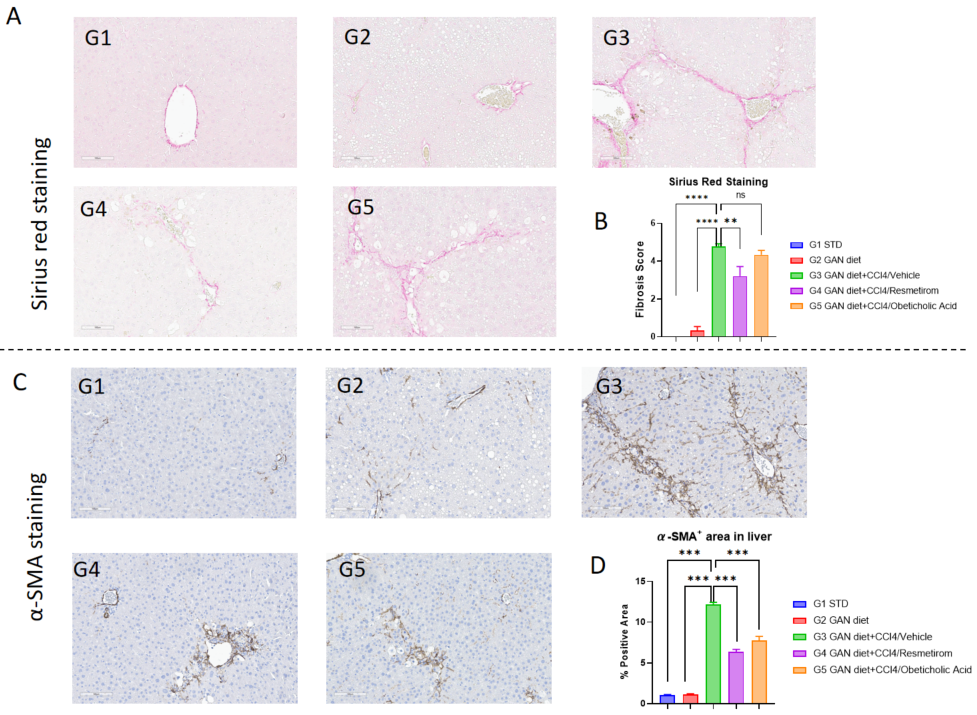
Resmetirom과 OCA는 간 섬유화를 완화시켰다. A, Sirius Red 염색의 대표적인 이미지에서 간 섬유화 정도를 보여줌(스케일: 200μm). B, Sirius Red 염색을 기반으로 평가된 간 섬유화 점수. C, IHC 염색의 대표적인 이미지에서 α-SMA 발현을 보여줌(스케일: 200μm). D, α-SMA 발현의 정량화된 데이터. 데이터는 평균 ± SEM으로 표시됩니다. 각 군 N = 9 마리의 마우스. *p<0.05, **p<0.01, ***p<0.001, ****p<0.0001.


MGL3196과 Semaglutide는 Gubra-Amylin 식이 유도 NASH 모델에서 B-ob/ob 마우스의 증상을 완화시켰다. A-B, 모델링 및 치료군의 ALT 및 AST 수준. C-F, 모델링 및 치료군의 TG, TC, HDL-C, LDL-C 수준. 데이터는 평균 ± SEM으로 표시됩니다. 각 군 N = 9 마리의 마우스. *p<0.05, **p<0.01, ***p<0.001.
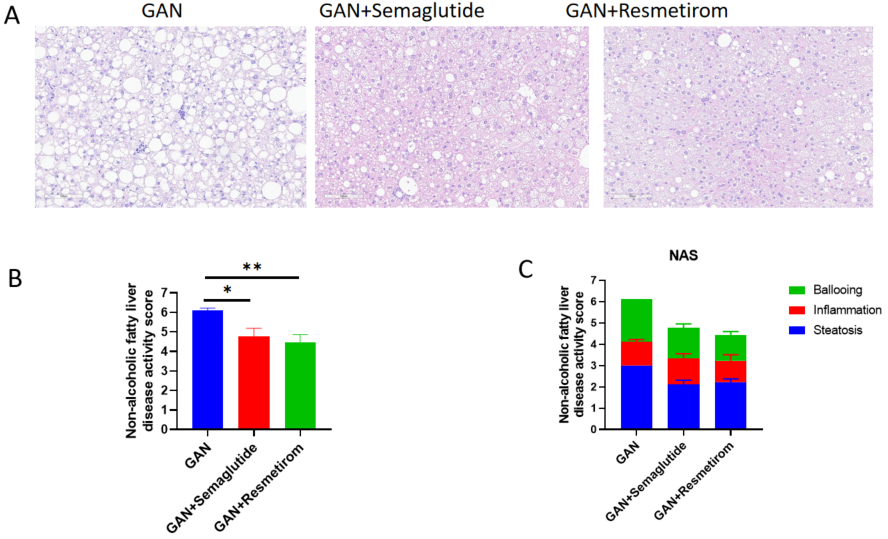
Semaglutide와 Resmetirom은 GAN 식이 유도 B-ob/ob 마우스의 NAS 점수를 감소시켰다. A, H&E 염색의 대표적인 이미지에서 NASH 정도를 보여줌. B-C, 외부 전문가 병리학자가 평가한 NAFLD 활동 점수(NAS). 데이터는 평균 ± SEM으로 표시됩니다. 각 군 N = 9 마리의 마우스. *p<0.05, **p<0.01.
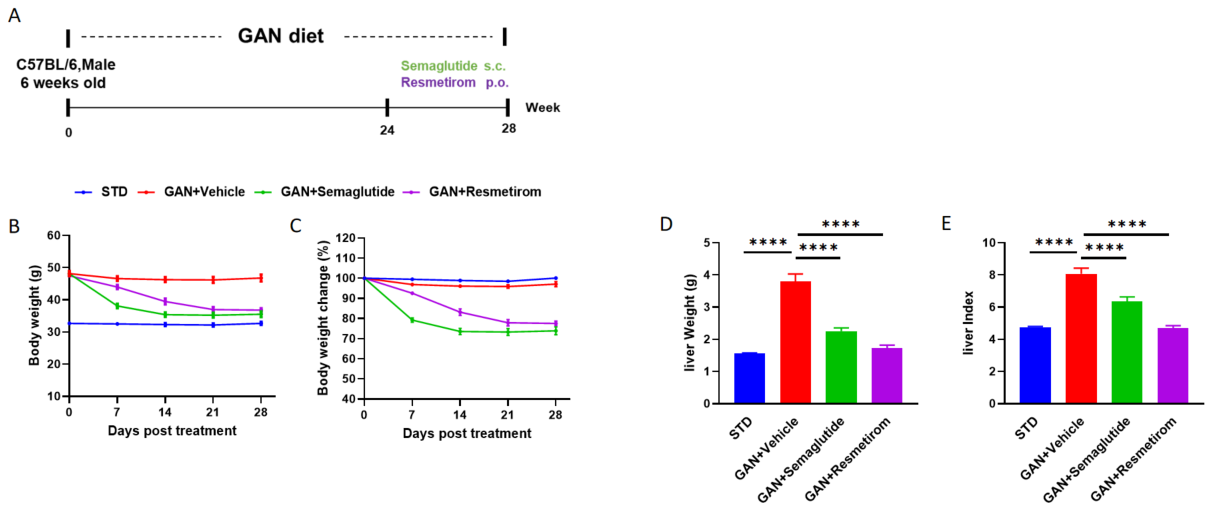
GAN 식이 유도 NASH 모델(C57BL/6 마우스). A, GAN DIO-NASH 마우스의 모델링 및 치료를 나타내는 실험 설계. B-C, 치료 후 체중 및 체중 변화 비율. D-E, 연구 종료 시 간 무게 및 간 지수. 각 군 N = 9-10 마리의 마우스. *p<0.05, **p<0.01, ***p<0.001, ****p<0.0001.
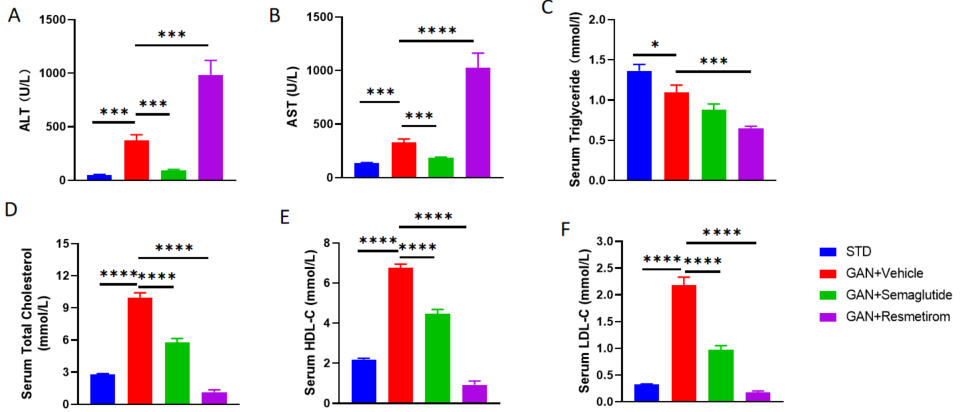
GAN 식이 유도 NASH 모델(C57BL/6 마우스). A-B, 연구 종료 시 각 군의 ALT 및 AST 수준 분석. C-F, 연구 종료 시 각 군의 혈청 TG, TC, HDL-C, LDL-C 수준. 데이터는 평균 ± SEM으로 표시됩니다. 각 군 N = 9-10 마리의 마우스. *p<0.05, **p<0.01, ***p<0.001, ****p<0.0001.
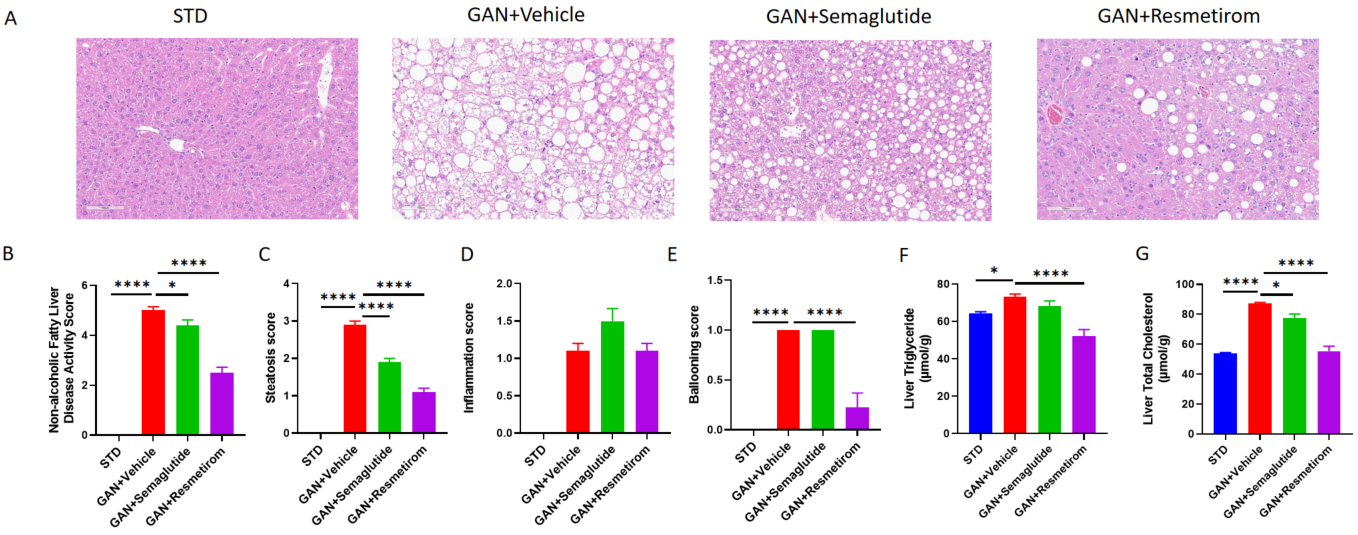
Semaglutide와 Resmetirom은 GAN DIO-NASH 모델에서 간 조직학적 영향을 미쳤다. A, H&E 염색의 대표적인 이미지에서 NASH 정도를 보여줌. B-E, NAFLD 활동 점수(NAS), 지방 변성 점수, 풍선 변성 점수 및 염증 점수의 조직학적 평가. F-G, 연구 종료 시 TG 및 TC 함량. 데이터는 평균 ± SEM으로 표시됩니다. 각 군 N = 9-10 마리의 마우스. *p<0.05, **p<0.01, ***p<0.001.
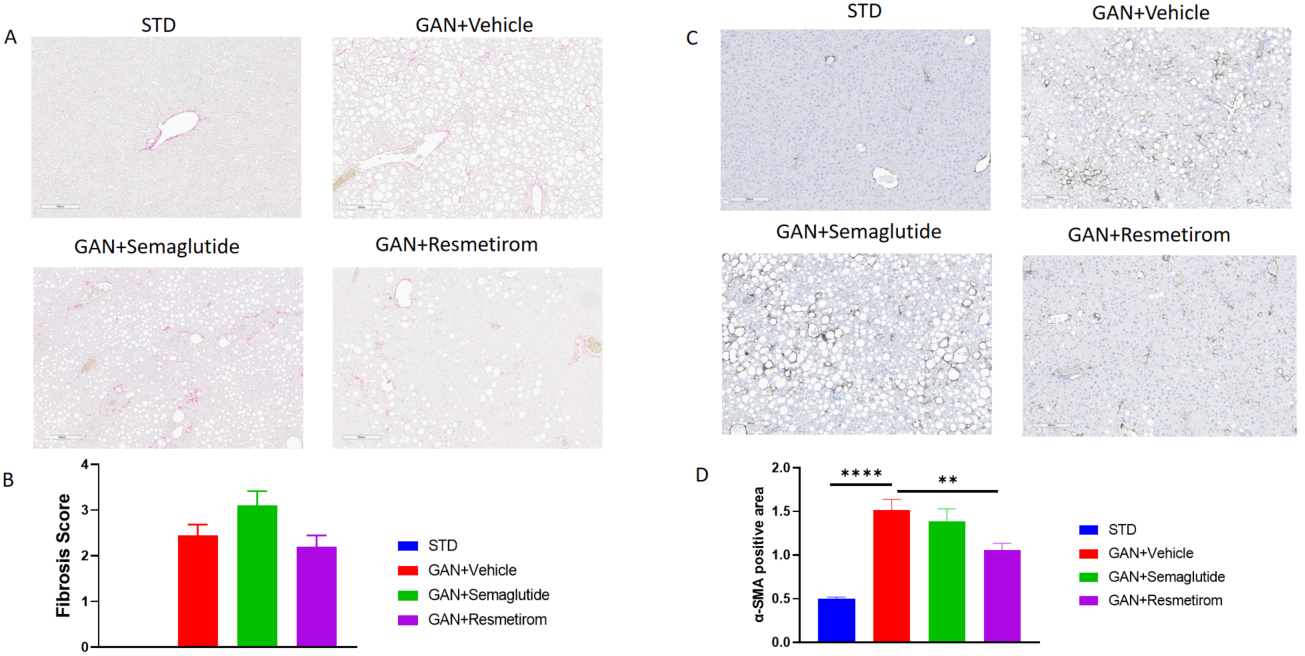
A, Sirius Red 염색의 대표적인 이미지에서 간 섬유화 정도를 보여줌(스케일: 200μm). B, Sirius Red 염색을 기반으로 평가된 간 섬유화 점수. C, IHC 염색의 대표적인 이미지에서 α-SMA 발현을 보여줌(스케일: 200μm). D, α-SMA 발현의 정량화된 데이터. 데이터는 평균 ± SEM으로 표시됩니다. 각 군 N = 9-10 마리의 마우스. *p<0.05, **p<0.01, ***p<0.001, ****p<0.0001.
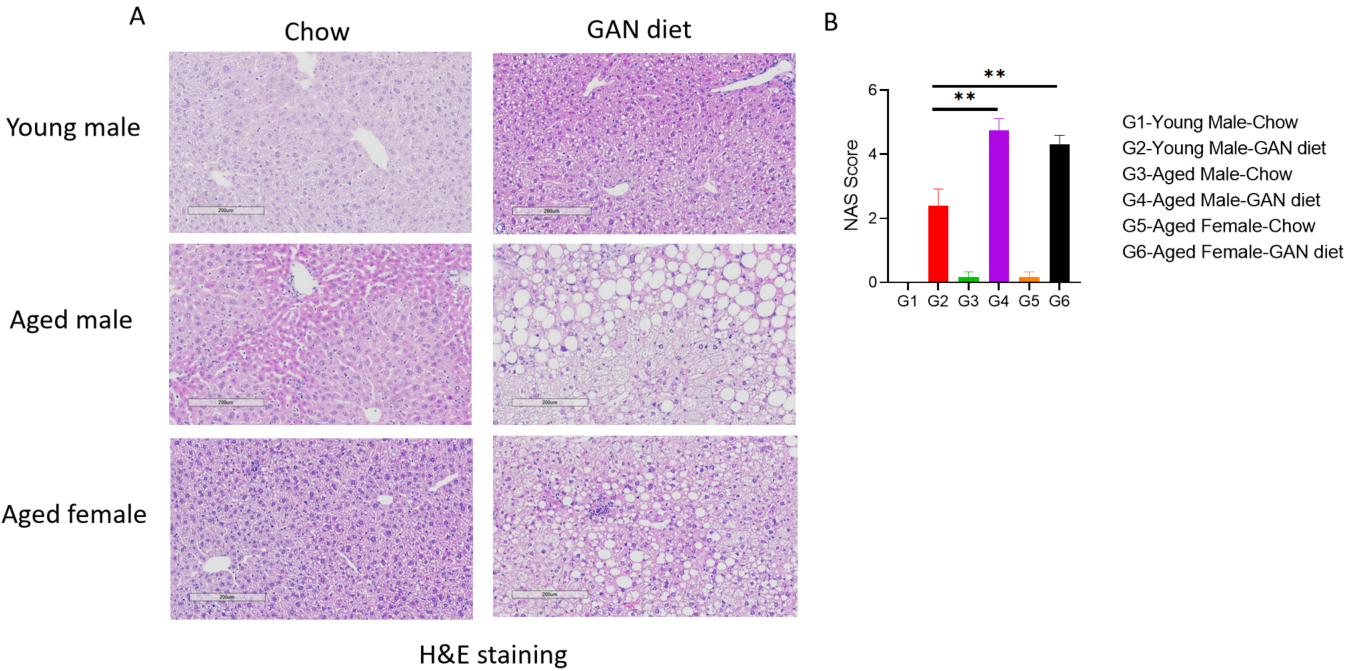
Gubra-Amylin 식이 유도 NASH(비알콜성 지방간염)는 고령 마우스에서 발생한다. A, 12주 유도 후 H&E 염색의 대표적인 이미지. B, 외부 전문가 병리학자가 평가한 NAFLD 활동 점수(NAS). 각 군 N = 6-10 마리의 마우스. 데이터는 평균 ± SEM으로 표시됩니다. **: p<0.01.

8주령 C57BL/6 수컷 마우스는 표준식(SDT) 또는 고지방 메티오닌 담즙 결핍식을 4주 또는 6주 동안 제공받음.
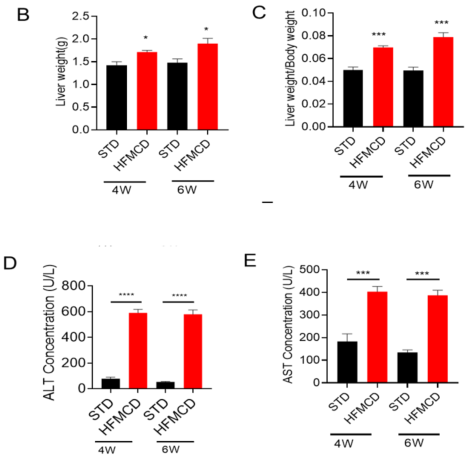
HFMCD 유도 NASH 모델의 표현형 분석. A, 모델링 다이어그램. B-C, 4주 및 6주 유도 후 간 무게 및 간 무게/체중 비율; 각 군 n = 5 마리의 마우스. D-E, HFMCD 유도 후 ALT 및 AST 수준. 데이터는 평균 ± SEM으로 표시됩니다. *p<0.05, ***p<0.001, ****p<0.0001.

HFMCD 유도 NASH 마우스 모델의 H&E 및 Sirius Red 염색 분석. A, HFMCD 그룹의 H&E 염색 대표 이미지에서 간 지방 변성 및 염증 증가를 나타냄. B, 외부 전문가 병리학자가 평가한 NAFLD 활동 점수(NAS), HFMCD 유도 후 NAS가 유의미하게 증가. 스케일: 50μm. 데이터는 평균 ± SEM으로 표시됩니다. 각 군 N = 6 마리의 마우스. *p<0.05, ****p<0.0001.

HFMCD 유도 NASH 마우스 모델에서 H&E 염색, 간 기능 지표 및 NAFLD 활동 점수 분석. A, Celastrol 치료 후 H&E 염색의 대표적인 이미지에서 간 지방 변성 및 염증 감소를 보여줌. B, MCD 유도 후 ALT/AST 변화. NAFLD 활동 점수(NAS) 통계. 데이터는 평균 ± SEM으로 표시됩니다. 각 군 N = 6 마리의 마우스. **p<0.01, ***p<0.001.


STAM 모델의 특징 분석. 신생雄마우스는 2일째에 STZ를 주사하고 4주령부터 고지방식(HFD)을 공급받음. A-C, 유도 후 체중 및 혈당 변화. 각 군 N = 8 마리의 마우스.
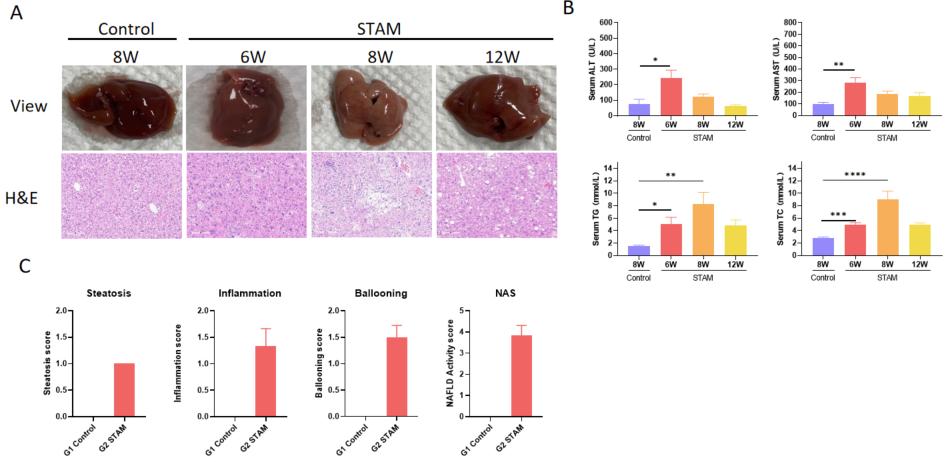
STAM 모델의 특징 분석. A, 6주, 8주 및 12주 유도 후 H&E 염색의 대표적인 이미지. B, STAM 모델의 특징을 나타내는 혈액 생화학 결과. C, NAFLD 활동 점수. 데이터는 평균 ± SEM으로 표시됩니다. 각 군 N = 8 마리의 마우스. *p<0.05, **p<0.01, ***p<0.001, ****p<0.0001.
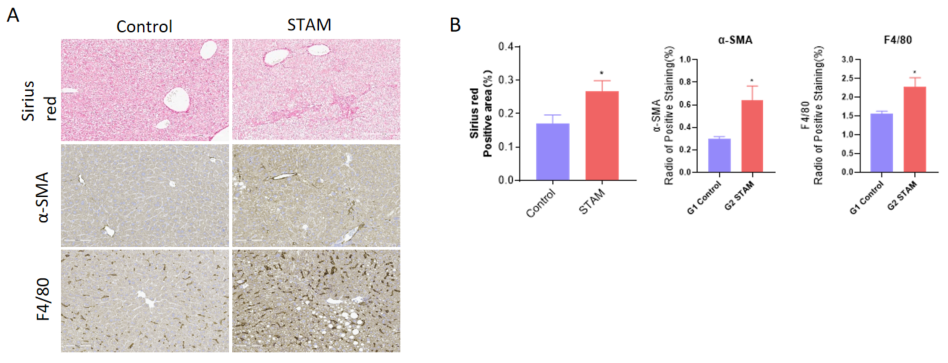
STAM 모델에서 섬유화 및 염증 분석. A, 9주 유도 후 Sirius Red 및 IHC 염색의 대표적인 이미지. B, Sirius Red 및 IHC 염색의 정량화된 데이터. 데이터는 평균 ± SEM으로 표시됩니다. 각 군 N = 8 마리의 마우스. *p<0.05.
| GAN diet+CCL4 | GAN diet | HFMCD | STAM | |||
| Animal | C57BL/6 | C57BL/6 | C57BL/6 (Aged) | B-ob/ob | C57BL/6 | C57BL/6 (Neonatal) |
| Obesity | + | + | + | + | - | - |
| Dyslipidemia | + | + | + | + | Decreased TG and TC | + |
| Hepatomegaly | + | + | + | + | + | + |
| Liver enzymes | + | + | + | + | + | + |
| Steatosis | + | + | + | + | + | + |
| Inflammation | + | Mild | + | + | + | + |
| Fibrosis | + | Mild | Mild | Mild | + | + |
| Induction period (weeks) | 14 | 20-35 | 12-20 | 12-16 | 4-8 | 6-9 |
참고 문헌